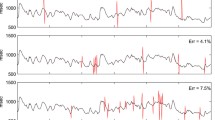Abstract
Three automatic approaches to ventricular repolarisation duration measurement (R-Tapex, R-Tend threshold and R-Tend fitting methods) are compared on computer-generated and real ECG signals, in relation to their reliability in the presence of the most common electrocardiographic artefacts (i.e. additive broadband noise and additive and multiplicative periodical disturbances). Simulations permit the evaluation of the amount of R-T beat-to-beat variability induced by the artefacts. The R-Tend threshold method performs better than the R-Tend fitting one, and, hence, the latter should be used with caution when R-Tend variability is addressed. Whereas the R-Tapex method is more robust with regard to broadband noise than the R-Tend threshold one, the reverse situation is observed in the presence of periodical amplitude modulations. A high level of broadband noise does not prevent the detection of the central frequency of underlying R-T periodical changes. Comparison between the power spectra of the beat-to-beat R-T variability series obtained from three orthogonal ECG leads (X,Y,Z) is used to assess the amount of real and artefactual variability in 13 normal subjects at rest. The R-Tapex series displays rhythms at high frequency (HF) with a percentage power on the Z lead (57.1±4.9) greater than that on the X and Y leads (41.9±4.6 and 46.1±4.9, respectively), probably because of respiratory-related artefacts affecting the Z lead more remarkably. More uniform HF power distributions over X,Y,Z leads are observed in the R-Tend threshold series (31.8 ±3.8, 39.2±4.1 and 35.1±4.2, respectively), thus suggesting minor sensitivity of the R-Tend threshold measure to respiratory-related artefacts.
Similar content being viewed by others
References
Arnold, L., Page, J., Attwell, D., Cannell, M., andEisner, D. A. (1982): ‘The dependence on heart rate of the human ventricular action potential duration’,Cardiovasc. Res.,16, pp. 547–551
Barr, C. S., Nass, A., Freeman, M., Lang, C. C. andStruthers, A. D., (1994): ‘QT dispersion and sudden death in heart failure’,Lancet,343, pp. 327–329
Bazett, H. C. (1920): ‘An analysis of the time-relations of electrocardiograms’,Heart,7, pp. 353–370
Browne, K. F., Prystowsky, E., Heger, J. J., andZipes D. P. (1983): ‘Modulation of the Q-T interval by the autonomic nervous system’,Pace,6, pp. 1050–1055
Day, C. P., McComb, J. M., andCampbell, R. W. F. (1990): ‘QT dispersion: an indicator of arrhythmia risk in patients with long QT intervals’,Br. Heart J.,63, pp. 342–344
Edvardsson, N., andOlsson, S. B. (1981): ‘Effects of acute and chronic beta-receptor blockade on ventricular repolarisation in man’,Br. Heart J.,45, pp. 628–636
Fayn, J., andRubel, P. (1988): ‘CAVIAR: a serial ECG processing system for the comparative analysis of VCGs and their interpretation with autoreference to the patient’,J. Electrocardiol.,21, pp. 173–176
Higham, P.D., andCampbell R.W.F. (1994): ‘QT dispersion’,Br. Heart J.,71, pp. 508–510
Johnsen, S. J. andAndersen, N. (1978): ‘On power estimation in maximum entropy spectral analysis’,Geophysics,43, pp. 681–690
Kay, S. M. (1988): ‘Modern spectral analysis: theory and applications’ (Prentice Hall, Englewood Cliffs, New Jersey)
Laguna, P., Thakor, N.V., Caminal, P., Jane, R., Yoon, H., Bayes-De-Luna, A., Marti, V., andGuindo J., (1990): ‘New algorithm for QT interval analysis in 24-hour Holter ECG: performance and applications’,Med. Biol. Eng. Comput.,26, pp. 67–73
Lepeschkin, E., andSurawicz B. (1952): ‘The measurement of the Q-T interval of the electrocardiogram’,Circ.,51, pp. 378–388
Lombardi, F., Sandrone, G., Porta, A., Torzillo, D., Terranova, G., Baselli, G., Cerutti, S., andMalliani, A. (1996): ‘Spectral analysis of short term R-Tapex interval variability during sinus rhythm and fixed atrial rate’,Europ. Heart J.,17, pp. 769–778
Maison Blanche, P., Catuli, D., Fayn, J., andCoumel, P., (1996): ‘QT interval, heart rate and ventricular arrhythmias’in Moss, A., andStern, S. (Eds): ‘Non-invasive electrocardiology. Aspects of Holter monitoring’ (W. B. Saunders Company Ltd, London) pp. 383–404
Merri, M., Alberti, M., andMoss, A. J. (1993): ‘Dynamic analysis of ventricular repolarisation duration from 24-hour Holter recordings’,IEEE Trans. BME-40, pp. 1219–1225
Nollo, G., Speranza, G., Grasso, R., Bonamini, R., Mangiardi, L., andAntolini, R. (1992): ‘Spontaneous beat-to-beat variability of the ventricular repolarisation duration’,J. Electrocardiol.,25, pp. 9–17
Pagani, M., Lombardi, F., Guzzetti, S., Rimoldi, O., Furlan, R., Pizzinelli, P., Sandrone, G., Malfatto, G., Dell'orto, S., Piggaluga, E., Turiel, M., Baselli, G., Cerutti, S., andMalliani, A. (1986): ‘Power spectral analysis of heart rate and arterial pressure variabilities as a marker of sympathovagal interaction in man and conscious dog’,Circ. Res.,59, pp. 178–193
Porta, A., Lombardi, F., Benedetti, M., Sandrone, G., Baselli, G., Malliani, A., andCerutti, S., (1994): ‘Reliability of the measurement of the RT variability’.Comp. in Cardiol. Conf. 1994, IEEE Computer Society Press, pp. 217–220
Schouten, E.G., Dekker, J.M., Meppelink, P., Kok, F.J., Vandenbroucke, J.P., andPool, J. (1991): ‘QT interval prolongation predicts cardiovascular mortality in an apparently healthy population’,Circ.,84, pp. 1516–1523
Schwartz, P. J., andWolf, S. (1978): ‘Q-T interval prolongation as predictor of sudden death in patients with myocardial infarction’,Circ.,57, pp. 1074–1077
Schwartz, P. J. andWolf, S. (1978): ‘Q-T interval prolongation as predictor of sudden death in patients with myocardial infarction’,Circ.,57, pp. 1074–1077
Speranza, G., Nollo G., Ravelli, F., andAntolini, R., (1993): ‘Beat-to-beat measurement and analysis of the R-T interval in 24 h ECG Holter recordings’,Med. Biol. Eng. Comput.,31, pp. 487–494
Yamada, A., Hayano, J., Hore, K., Ieda, K., Mukai, S., Yamada, M., andFujinami, T. (1993): ‘Regulation of QT interval during postural transitory changes in heart rate in normal subjects’,Am. J. Cardiol.,71, pp. 996–998
Author information
Authors and Affiliations
Corresponding author
Rights and permissions
About this article
Cite this article
Porta, A., Baselli, G., Lambardi, F. et al. Performance assessment of standard algorithms for dynamic R-T interval measurement: comparison between R-Tapex and R-Tend approach. Med. Biol. Eng. Comput. 36, 35–42 (1998). https://doi.org/10.1007/BF02522855
Received:
Accepted:
Issue Date:
DOI: https://doi.org/10.1007/BF02522855




